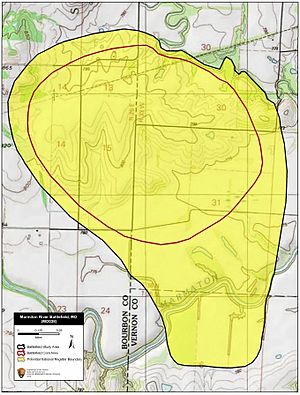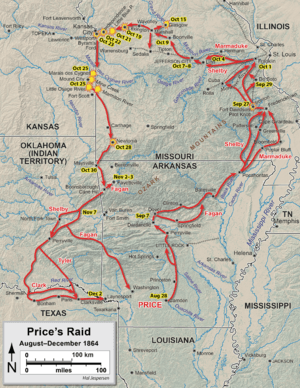Battle of Marmiton River facts for kids
Quick facts for kids Battle of Marmiton River |
|||||||
|---|---|---|---|---|---|---|---|
| Part of Price's Raid during the American Civil War |
|||||||
 Map of the battlefield |
|||||||
|
|||||||
| Belligerents | |||||||
| Commanders and leaders | |||||||
| John McNeil Frederick W. Benteen |
Sterling Price Joseph O. Shelby |
||||||
| Units involved | |||||||
| Department of the Missouri | Army of Missouri | ||||||
| Strength | |||||||
| Two brigades | c. 1,000–4,000 | ||||||
| Casualties and losses | |||||||
| Light | c. 75 | ||||||
The Battle of Marmiton River happened on October 25, 1864. It is also known as Shiloh Creek or Charlot's Farm. This battle took place in Vernon County, Missouri. It was part of the American Civil War.
Major General Sterling Price, a Confederate leader, started a big trip into Missouri in September 1864. He hoped to take control of the state for the Confederacy. But after losing a major battle at Battle of Westport on October 23, Price began to retreat south. He faced another big defeat at the Battle of Mine Creek early on October 25.
Later that afternoon, Price's supply wagons got stuck. They were trying to cross the Marmaton River in western Missouri. A group of Confederate soldiers, led by Brigadier General Joseph O. Shelby, tried to stop the Union cavalry. These Union troops were led by Brigadier General John McNeil and Lieutenant Colonel Frederick W. Benteen. Shelby's men could not push back the Union soldiers. However, the Union horses were too tired for a close fight. As night fell, the Confederates pulled back. They destroyed many of their wagons. Price was defeated again on October 28 at the Second Battle of Newtonia. His retreat continued until his remaining soldiers reached Texas in early December.
Contents
Why the Battle Happened
In September 1864, during the American Civil War, Confederate Major General Sterling Price led an invasion of Missouri. He wanted to capture St. Louis and bring Missouri back under Confederate control.
Price's Retreat Begins
Price's army was stopped at the Battle of Pilot Knob in late September. So, they changed their plan and headed towards the Missouri River. The Union army, called the Army of the Border, started chasing Price. They defeated his Confederate forces at the Battle of Westport near Kansas City on October 23.
Losses at Mine Creek
Price's defeated army then retreated south. They suffered more losses at the battles of Marais des Cygnes and Battle of Mine Creek on October 25. The loss at Mine Creek was very bad. Many of Price's cannons and soldiers were captured. This included two of his generals, John S. Marmaduke and William L. Cabell.
Shelby's Rear Guard Action
Brigadier General Joseph O. Shelby's division arrived to protect the back of Price's army. This group is called a rear guard. Shelby's men fought a delaying action against the Union soldiers. This happened at the crossing of the Little Osage River. The Union cavalry eventually pushed past them. But Shelby's defense bought Price's army some valuable time to escape.
The Battle of Marmiton River
On the afternoon of October 25, Price's army was in western Missouri. Their wagon train got stuck while trying to cross the Marmaton River. This was similar to what happened at Mine Creek.
Confederate Defenses
Price quickly set up a line of soldiers to protect his wagons from the Union army. The front of his line included soldiers from M. Jeff Thompson's brigade. It also had what was left of other divisions that were badly beaten at Mine Creek. Some soldiers in these groups did not even have weapons. The rest of the divisions formed a second line. Colonel Sidney D. Jackman's brigade was kept in reserve. Price had about 8,000 men. But many were too tired, sad, or unarmed to fight. Only about 1,000 to 4,000 Confederates were actually ready to fight.
Union Attack
Union cavalry troops caught up to Price's line. These troops were led by Brigadier General John McNeil and Lieutenant Colonel Frederick W. Benteen. When the Union forces arrived, Shelby ordered some of his men to charge. But this attack was quickly stopped by McNeil's soldiers.
The Union forces then brought up their cannons. Shelby tried several tricks to hold off the Union troops. But his attacks were also pushed back. The Union cavalry tried to charge the Confederate line. However, they had to wait because their charge would block their own cannons' firing path. The Union cannons had to move.
Tired Horses and Retreat
When the Union attack started again, their horses were too tired to run fast. The Confederates still had three working cannons. But they did not use them. They might have been afraid of losing them, as most of their cannons were captured at Mine Creek. The Union cavalry could not reach the Confederate line because their horses were so tired. But some of the Confederate soldiers, especially in Thompson's group, started to retreat anyway.
Near dusk, Jackman's brigade, which was in reserve, charged the Union line. Jackman's charge forced the 4th Iowa Cavalry to pull back. As night fell, the Confederates withdrew, and the fighting stopped.
Aftermath of the Battle
The Union army had very few losses in this battle. The Confederates lost about 75 men. About a third of them were killed. That night, Price decided to destroy any wagons that were not absolutely needed.
A Shattered Army
By this point, the Confederate army was in very bad shape. One historian, Albert E. Castel, said it was like an armed mob. By the end of October 26, Price's army had moved back to Carthage, Missouri. There, they finally got food. Some soldiers had not eaten for six days.
Continued Retreat
On October 28, Price was defeated again at the Second Battle of Newtonia. The Confederates then retreated into Arkansas. Union forces chased them to the Arkansas River. Price kept retreating. What was left of his army finally reached Texas in early December.
Preserving the Battlefield
The land where the battle happened is still in good condition. However, there are some worries about how the land might be used in the future. The Civil War Sites Advisory Commission (CWSAC) noted that the land looks much like it did in 1864.
Future Protection
Right now, none of the battlefield is officially protected. But the CWSAC believes that about 1,488 acres (602 hectares) of the site could be added to the National Register of Historic Places. The site is also part of the Freedom's Frontier National Heritage Area. There are signs and information for visitors, but no visitor's center.


